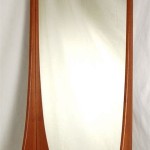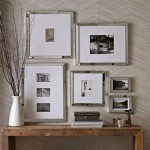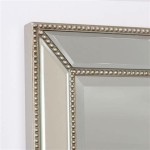Arts and Crafts Mirror Frames
The Arts and Crafts movement, flourishing between 1880 and 1920, significantly impacted decorative arts, including mirror design. Rejecting the mass-produced ornamentation of the Victorian era, the movement championed handcrafted simplicity, natural materials, and traditional craftsmanship. Arts and Crafts mirror frames exemplify these principles, showcasing honest construction and the beauty of natural wood.
Key Characteristics of Arts and Crafts Mirror Frames
Several key features define Arts and Crafts mirror frames, setting them apart from other styles. Understanding these elements provides a framework for identifying and appreciating authentic pieces and those inspired by the movement.
Emphasis on Simple Lines and Geometric Shapes
Arts and Crafts aesthetics prioritized functionality and simple, clean lines. Rectangular and square frames were common, often featuring gentle curves or subtle tapers. Ornamentation, if present, was typically geometric and restrained, emphasizing the frame's structure rather than elaborate embellishment. This simplicity allowed the natural beauty of the wood to take center stage.
Use of Natural Materials
Oak, cherry, and walnut were popular choices for Arts and Crafts furniture and mirror frames, prized for their rich color and grain. The wood was often left unpainted or finished with a clear varnish or stain to highlight its natural characteristics. The focus on natural materials aligned with the movement's philosophy of celebrating the inherent beauty of nature.
Handcrafted Construction and Visible Joinery
The Arts and Crafts movement valued handcrafted items over mass-produced goods. Mirror frames often showcased visible joinery techniques, such as mortise and tenon or dovetail joints. These exposed joinery details served as a testament to the craftsman's skill and the piece's handcrafted nature, further emphasizing the movement's rejection of industrial production.
Influence of Nature and Medieval Design
Designs often incorporated stylized natural motifs, such as leaves, flowers, or birds. These elements were typically integrated subtly, complementing the frame's overall simplicity rather than dominating the design. Additionally, the Arts and Crafts movement drew inspiration from medieval art and architecture, evident in some frames' arched tops or pointed finials.
Integration with the Surrounding Decor
Arts and Crafts furniture and decor were designed to create harmonious and unified interiors. Mirror frames were often designed as integral parts of larger furniture pieces, such as dressers or sideboards. Even when hung as standalone pieces, they were intended to complement the overall aesthetic of the room, contributing to a cohesive and functional living space.
Identifying and Collecting Arts and Crafts Mirror Frames
Identifying authentic Arts and Crafts mirror frames requires careful examination. Look for the hallmarks of the style: simple lines, natural materials, handcrafted construction, and subtle ornamentation. Antique shops, auctions, and specialized dealers are good places to search for original pieces. However, the popularity of the Arts and Crafts style has led to numerous reproductions. Careful research and attention to detail are essential for discerning authentic pieces from later imitations.
Modern Interpretations and Inspirations
The Arts and Crafts aesthetic continues to influence contemporary design, with many artisans and manufacturers creating pieces inspired by the movement. Modern interpretations of Arts and Crafts mirror frames often retain the core principles of simplicity and natural materials while incorporating contemporary design elements. These pieces offer an opportunity to bring the timeless elegance of the Arts and Crafts style into modern homes.
Caring for Arts and Crafts Mirror Frames
Proper care ensures the longevity of Arts and Crafts mirror frames. Dusting regularly with a soft cloth helps maintain the finish. Avoid using harsh chemicals or abrasive cleaners, which can damage the wood or finish. Exposure to excessive sunlight or moisture should be avoided. Consulting with a professional conservator is recommended for significant damage or restoration.

Arts And Crafts Wall Mirror Hand Crafted Mantle

Arts Crafts Style Beveled Mirror With Mortise And Tenon Joinery Display Shelf Hand Carved Glaz Craftsman Mirrors Frames Art Nouveau Furniture

Arts And Crafts Framed Mirror Mission Style Corner Pinned 28 X 45 Mahogany Finish W Clear Coat

Arts And Crafts Framed Mirror Mission Style Corner Pinned 28 X 45 Mahogany Finish W Clear Coat

Arts Crafts Style Framed Beveled Mirror W 4 X8 Medicine Bluff Night Owl Art Tile

Arts Crafts Mahogany Mirror By J M Middelraad For H Pander Zn 1900s At Pamono

New Arts Crafts Movement Style Mirror Frames

Arts And Crafts Wall Mirrors Hand Made Craftsman Style
Mirrors Holton Studio Frame Makers Sf Bay Area

This Item Is Unavailable Craftsman Furniture Mission Style Wooden Front Door Design








